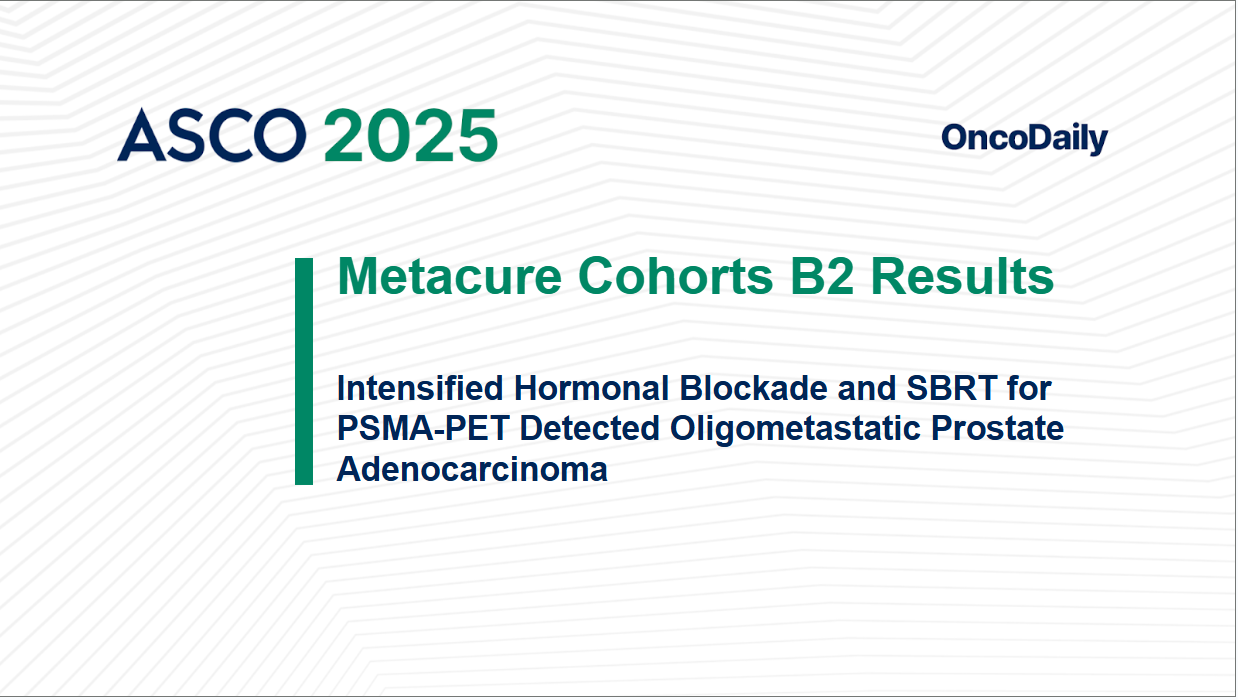
Metacure Cohorts B2 Results: Intensified Hormonal Blockade and SBRT for PSMA-PET Detected Oligometastatic Prostate Adenocarcinoma
The ASCO Annual Meeting 2025 is happening from May 30 to June 3 in Chicago. It’s the top global meeting for cancer doctors, researchers, and industry experts. They all come together at McCormick Place to share new discoveries, discuss latest cancer treatments, and plan what’s next for cancer care. You can expect to hear about important clinical trial results, exciting new research, and ideas to make patient care better and fairer.
What Is the Metacure Trial?
The Metacure trial is a multi-center, multi-arm randomized Phase 2 study designed to investigate novel systemic therapies in conjunction with multimodality approaches, specifically stereotactic body radiotherapy (SBRT) to oligometastatic sites. The trial aims to define the optimal intensity and duration of hormonal blockade when combined with SBRT for patients with oligometastatic hormone-sensitive prostate cancer (HSPC). This approach builds upon the standard of care, where metastasis-directed therapy (MDT) with SBRT is used to delay the need for continuous androgen deprivation therapy (ADT). The B2 and B2 expansion cohorts of Metacure specifically examined the combination of SBRT with time-limited ADT plus androgen receptor pathway inhibitors (ARPI) in patients with PSMA-PET detected metachronous oligometastatic HSPC.
Trial Endpoints and Translational Aims
The primary endpoint for the B2 and B2 expansion cohorts was the proportion of patients achieving an undetectable PSA (PSA <0.1) at 12 months from the start of treatment, specifically among those who had recovered their testosterone (T) levels. This endpoint aims to evaluate the depth and durability of response following the intensified, time-limited treatment.
Secondary objectives included assessing PSA <0.1 at 24 months, time to PSA progression (PSA 0.2), time to testosterone recovery, radiographic progression-free survival (rPFS), and overall progression-free survival (PFS), defined by PSA, radiographic, or clinical progression, or death.
The translational aim of the Metacure trial is to identify an intensified yet time-limited systemic therapy regimen that, when combined with SBRT, can achieve durable control of oligometastatic disease while minimizing the long-term side effects of continuous hormonal therapy. By using PSMA-PET for precise metastasis detection, the study aims to refine patient selection and maximize the therapeutic benefit of MDT, ultimately seeking to improve long-term outcomes and patient quality of life.
Read More ASCO 2025 Updates on OncoDaily’s Website
Metacure Trial Results
A total of 36 patients were treated across the combined B2 (10 patients) and B2 expansion (26 patients) cohorts. The median follow-up periods were 35 months for cohort B2 and 19 months for the B2 expansion, allowing for meaningful assessment of long-term outcomes.
Efficacy Outcomes
The study showed promising efficacy with the intensified short-course hormonal blockade plus SBRT. Testosterone recovery (>150ng/dl) at 12 months occurred in 60% of ADT+APA+AAP patients and 40% of ADT+APA patients in cohort B2, and 54% of patients in the B2 expansion (ADT+APA). Among those who recovered testosterone, 100% of B2 ADT+APA+AAP patients (2/2), 100% of B2 ADT+APA patients (3/3), and 79% (11/14) of B2 expansion patients achieved undetectable PSA (<0.1). This met the pre-specified activity threshold for the B2 expansion cohort.
The durability of disease control was also notable. Median time to PSA progression and median rPFS were not reached in the B2 ADT+APA arm or the B2 expansion cohort, indicating sustained control. Median time to PSA progression for the B2 ADT+APA+AAP arm was 26 months. At 12 months, all patients across both B2 and B2 expansion cohorts remained progression-free. At 18 months, PFS was 100% for B2 (ADT+APA) and 60% for B2 (ADT+APA+AAP), with 85% for the B2 expansion. At 24 months, PFS for B2 (both ADT+APA and ADT+APA+AAP) was 60%. Median testosterone recovery occurred at 3.0 months for B2 and 5.5 months for the B2 expansion cohorts, indicating relatively swift hormonal recovery after the time-limited blockade.
Safety Profile
The treatment regimen combining SBRT with short-course intensified hormonal blockade demonstrated a favorable safety profile. Grade 3 treatment-related adverse events (TRAEs) were infrequent, observed in 0 out of 10 patients in cohort B2 and only 1 out of 26 patients in the B2 expansion cohort. The reported Grade 3 TRAE was lymphopenia. No higher-grade TRAEs were noted in the presented abstract. These findings suggest that the intensified, time-limited approach is well tolerated, providing durable disease control without significant increase in severe adverse events.
You can watch more on OncoDaily Youtube TV
Written by Aren Karapetyan, MD
-
Challenging the Status Quo in Colorectal Cancer 2024
December 6-8, 2024
-
ESMO 2024 Congress
September 13-17, 2024
-
ASCO Annual Meeting
May 30 - June 4, 2024
-
Yvonne Award 2024
May 31, 2024
-
OncoThon 2024, Online
Feb. 15, 2024
-
Global Summit on War & Cancer 2023, Online
Dec. 14-16, 2023
